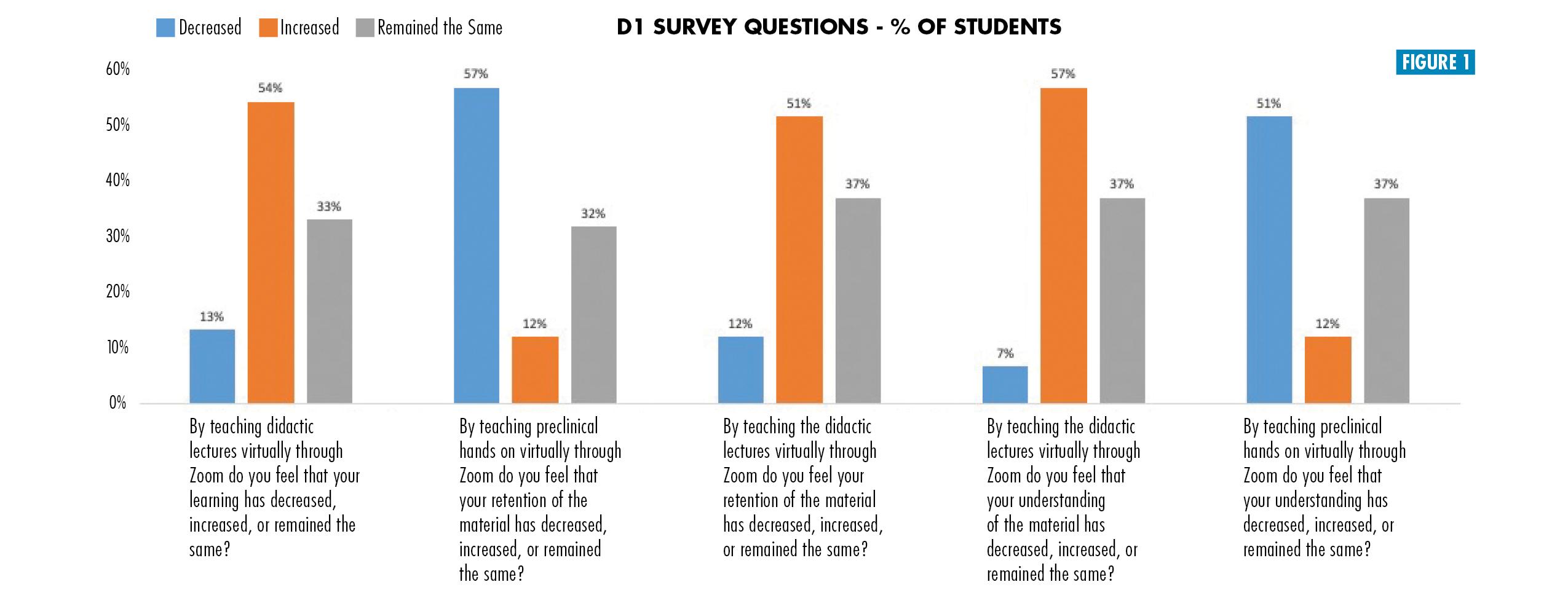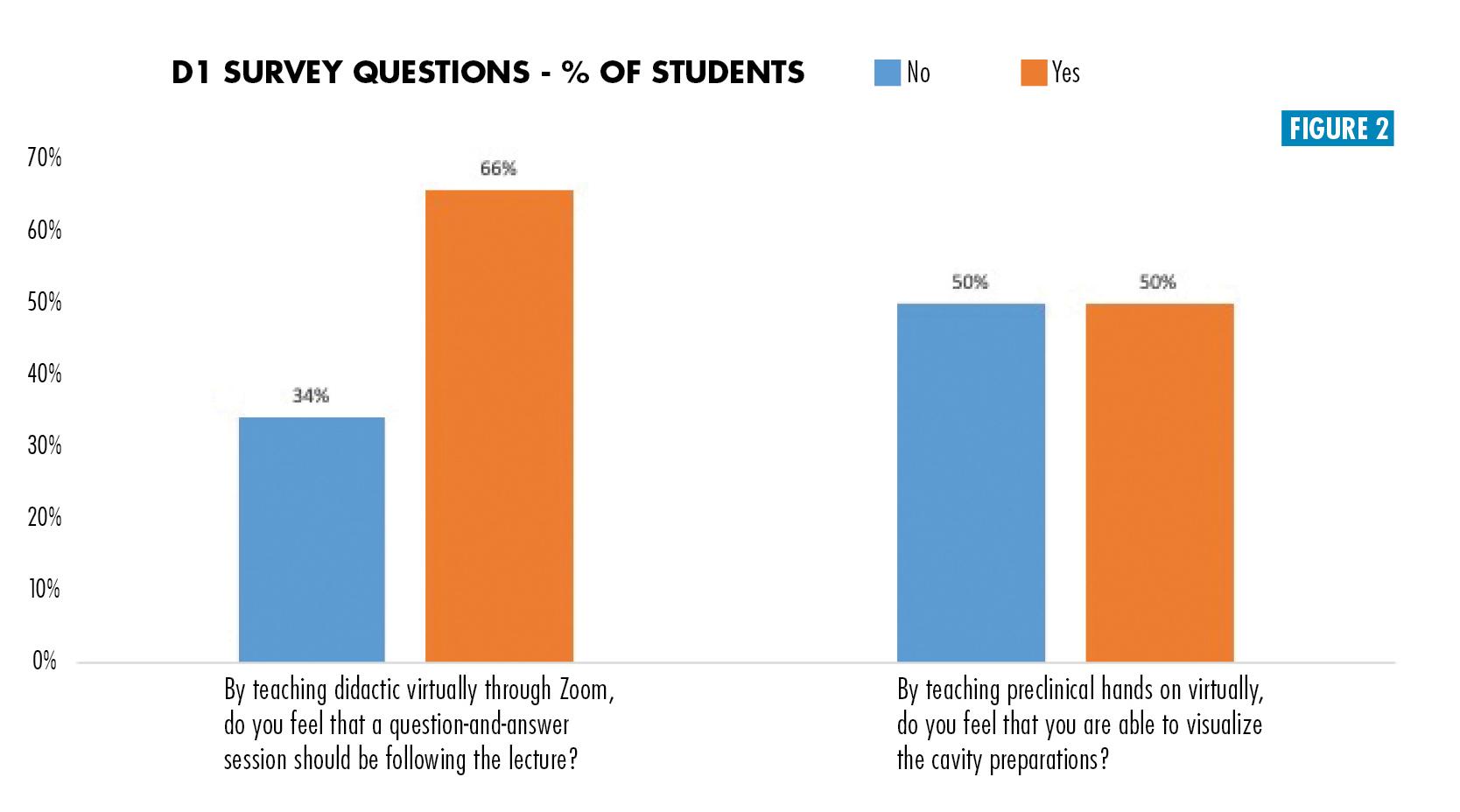
11 minute read
Students’ Perceptions of Teaching Methods for First-Year Dental Students during COVID-19
Students’ Perceptions of Teaching Methods for First-Year Dental Students during COVID-19
Ellen Lee, D.D.S.; Jungwon Roh; Aspen Wang; Aaron Bai, D.D.S.; Huan-yu Chen, D.D.S.
ABSTRACT
The purpose of this study is to determine student perceptions of teaching methods for first-year dental students using Zoom to teach didactics and preclinical hand skills. Because of COVID-19, other teaching methods had to be implemented, and classes were held remotely. Our aim is to determine student perceptions of retention, understanding and learning of didactic and preclinical hands-on lectures. Students felt that didactic lectures through Zoom increased their retention and understanding in learning the material. They felt that preclinical hands-on lectures through Zoom were not as effective for their learning.
Major changes in all aspects of life occurred because of the COVID-19 pandemic. For those in education, the need for social distancing resulted in changing from in-person learning to online formats. Dental faculty needed to use virtual conferences, and students had to adjust their learning to this. Zoom was the main online platform used by faculty during this time.
At New York University College of Dentistry, there is a firstyear preclinical course to prepare students for clinical work. This course involves both didactic lectures and hands-on lab work.
Students learn about cavity preparations and fillings. Because of the restrictions of COVID-19, previous educational curriculum had to be modified, while still ensuring that students received all of the necessary learning to become competent dentists.
This study evaluates the students’ preferences among the virtual formats.
Methods
The study was approved by the Institutional Review Board of New York University College of Dentistry (IRB#FY2021-5303) with exempt status. An 11-question survey was sent through Qualtrics to the first-year dental students (D1) at New York University College of Dentistry. This voluntary, anonymous survey asked the students if Zoom increased, decreased or had no effect on their retention and understanding of didactic and preclinical hands-on lectures. It also asked if Zoom increased, decreased or had no effect on their learning, if a question-and-answer session should be at the end of the lecture, if students were able to visualize cavity preps taught virtually and their gender.
There were 76 D1 students who responded to the survey. The class has a total of over 300 students.
Results
students felt that their retention decreased and 51% felt that their understanding decreased on preclinical hands-on lectures; 66% felt that a question-and-answer session should be at the end of the lecture; 50% felt that they could visualize cavity preps through Zoom and 50% said they could not (Figure 2).
students felt that their retention decreased and 51% felt that their understanding decreased on preclinical hands-on lectures; 66% felt that a question-and-answer session should be at the end of the lecture; 50% felt that they could visualize cavity preps through Zoom and 50% said they could not (Figure 2).
Discussion
Zoom is a software platform that allows for online video lectures to replace an in-person class. Learning through Zoom helped to increase retention and understanding of didactics. Both pre-pandemic in-person and online Zoom didactic courses are presented in a lecture format. Furthermore, in-person lectures and Zoom lectures are both recorded, which allows students to rewatch lectures. These similarities between in-person and Zoom lectures may account for a more seamless transition, as students indicated they were still able to increase their learning, retention and understanding of didactic material.
Prior to COVID-19, online learning programs were successfully implemented. The Vanderbilt University School of Nursing (VUSN) added a distanced learning option in 1996 and expanded the program over more than 20 years. Key factors for success included hiring additional staff for technology support, updating technological tool sets annually, implementing student and faculty technology orientations, and utilizing quality standards for course design. As a result, over 23 years, the VUSN Masters of Science in Nursing program rose to number eight in ranking for the year 2019, and the Doctor of Nursing Practice program rose to number five.[1]
A study of eLearning by Abassi et al. found that 40% of science students accepted eLearning as a good medium for acquiring theoretical knowledge and 47% preferred Zoom as an online platform.[2]

With Zoom, students can learn in a comfortable setting, as opposed to sitting in a lecture hall or classroom.[3] This is most helpful for commuting students. Many first-year dental students responded that they preferred Zoom lectures because they lived far from campus and did not have to commute to school. The time spent commuting was instead spent on reviewing or studying material. Armstrong-Mensah et al. found that more than a third of public health students surveyed at Georgia State School of Public Health reported that not having to commute to school was a positive outcome of distance learning.[4]

A recent survey conducted among first- to fourth-year dental students who had experienced both in-person and Zoom lectures found that students preferred podcast recordings over both Zoom and in-person lectures.[5] Likewise, Armstrong-Mensah et al.
found that most students also preferred this asynchronized style of online learning.[4] This preference may be because students have flexibility watching at faster speeds, pausing and replaying podcast recording.
Attendance rates and participation in lectures may be higher compared to when classes were in person.[6] Zoom involves multimedia learning, and students may be able to communicate with the lecturer and classmates more easily.[7]
One study of health science students found that nearly 75% of those surveyed considered clinics and laboratory environment more effective than eLearning for acquiring clinical and technical skills, and more than 75% of the students did not feel confident managing patients without practical and hands-on clinical sessions when returning to clinics after the pandemic.[2]
Another study of medical and dental faculty and students said they were unable to teach and learn practical and clinical work through online learning modalities.[8]
First-year dental students found that Zoom teaching was not as effective for retaining and understanding preclinical hands-on lectures. Comments from surveyed students suggest that courses with a hands-on focus do not translate well to online formats without proper preparation. Key issues include a lack of adequate demonstrations and resources, inadequate feedback due to the lack of student access to quality equipment and not enough time for actual hands-on practice.
Surveyed students felt that preclinical courses, such as Head & Neck Anatomy and Dental Anatomy, did not add new technologies or resources for viewing, highlighted by comments such as: “Learning hands-on skills through Zoom is hard to visualize and provides no real practice”; “It was a huge challenge for me to really visualize the cavity preparations”; and “Another recommendation would be a better demonstration for some of the operative procedures over Zoom in regards to the cavity preparations.”
Other comments illustrate that not all students had proper technology: “Without the professional camera, I could not show the professor what I did; they often hardly give some structural suggestions.”
First-year dental students were scheduled to have an inperson lab session once a week for the Dental Anatomy course. However, students felt that this was not enough time to practice, illustrated by comments such as: “Having lab only 1 day a week unfortunately was not enough time for me to master the hands-on portion of the course”; and “It’s hard to translate that into hand/physical skills without putting the time in.” Furthermore, some students felt that not enough faculty members were available on lab days to answer questions.
Students also reported that they wished there were step-bystep instructions for how to prepare teeth for restoration. This may be because students prefer to hear instructions while simultaneously watching the steps on video.
It is important for educators and faculty to take steps to make these changes because students have various learning styles and needs. However, it was found that educators may be hesitant to make the changes because of how time-consuming it is to learn to use new technology, and some believe it is too difficult to do so.[9]
A study of dental residents rated the face-to-face format as significantly more conducive to student-instructor and studentstudent interaction.[10] In addition, dental clinical teaching and clinical student training directly on patients under close and remote supervision of senior clinical professionals and mentors are key to developing the essential clinical skills, competencies and clinical decision-making abilities mandatory for a dental graduate and general dental practitioner.[11,12]
Some students may be able to comprehend what cavity preps look like just by watching a short video or pictures of preps. However, most dental school students prefer a multimodal learning style within the VARK (visual, aural, read/write and kinesthetic) learning preferences. This means that dental students prefer to learn through a combination of sensory learning pathways instead of just one. Most dental students incorporate VARK in their learning styles.[13]
Outside materials, such as YouTube videos, may have helped first-year dental students better visualize cavity preps.
Our survey found that 66% of students felt that a questionand-answer session should be at the end of the lecture. This suggests that first-year students recognize that some degree of faculty-student interaction, a component of synchronous learning, is necessary despite the artificial distance of online learning.
Videotaped feedback may help novice learners in preclinical teaching.[14]
Conclusion
Based on our survey, first-year dental students feel that didactic lectures through Zoom increased their retention and understanding in learning the material. They felt that preclinical hands-on lectures through Zoom were not as effective in their learning. Initiating a question-and-answer session after the lecture may help to increase retention and understanding of the Zoom lectures.
All authors have disclosed no relevant relationships. Queries about this article can be sent to Dr. Lee at el84@nyu.edu.
REFERENCES
1. Weiner E, McNew R, Gordon J, et al. Twenty plus years of distance learning: lessons learned. Student Health Technology Informatics 2019 Aug 21;264:1807-1808.
2. Abbasi MS, Ahmed N, Sajjad B, et al. E-Learning perception and satisfaction among health sciences students amid the COVID-19 pandemic.” Work 2020; 67(3):549-556.
3. Ruiz J, Mintzer M, Leipzig R. The impact of E-Learning in medical education. Academic Medicine 2006;81(31):207-212.
4. Armstrong-Mensah E, Ramsey-White K, Yankey B, Self-Brown S. COVID-19 and distance learning: effects on Georgia State University School of Public Health Students. Frontiers in Public Health. 8, 2020 Sep 25.
5. Impact of COVID-19 on different teaching methods. Chapter by: Lee E, Wang A, Roh J, Liang YS, Lee, TJ. In: Clinical & Educational Scholarship Showcase by New York NY: NYU College of Dentistry. NYU Academy of Distinguished Educators, 2021.
6. Schlenz MA, Schmidt A, Wöstmann B, et al. Students’ and lecturers’ perspective on the implementation of online learning in dental education due to SARS-CoV-2 (COVID-19): a cross-sectional study. BMC Medical Education 2020;20(1):354-361.
7. Nortvig AM., Petersen AK, Balle SH. A literature review of the factors influencing E-Learning and blended learning in relation to learning outcome, Student satisfaction and engagement. The Electronic Journal of E-Learning 2018;16(1):46-55.
8. Mukhtar K, Javed K, Arooj M, Sethi A. Advantages, limitations and recommendations for online learning during COVID-19 pandemic era. Pak J Med Sci 2020;36 (COVID19-S4): S27-S31.
9. Tricio JA, Montt JE, Ormeño AP, Del Real AJ, Naranjo CA. Impact of faculty development workshops in student-centered teaching methodologies on faculty members’ teaching and their students’ perceptions. J Dent Educ 2017;81(6):675-684.
10. Kunin M, Julliard KN, Rodriguez TE. Comparing face-to-face, synchronous, and asynchronous learning: postgraduate dental resident preferences. J Dent Educ 2014;78(6):856-866.
11. Elgezawi M, Hassan K, Alagl A, et al. Complexity of comprehensive care treatments in undergraduate dental programs: the benefits of observing and assisting experienced faculty members. Saudi Dent J 2017:29(4):161-166.
12. Taylor C, Grey N, Satterthwaite J. Assessing the clinical skills of dental students: a review of the literature. J Educ Learning 2013;2:20-31.
13. Aldosari MA, Aljabaa AH, Al-Sehaibany FS, Albarakati SF. Learning style preferences of dental students at a single institution in Riyadh, Saudi Arabia, evaluated using the VARK questionnaire. Advances in Medical Education and Practice 2018:9:179–186.
14. Shah DY, Dadpe, AM, Kalra DD, Garcha VP. Videotaped feedback method to enhance learning in preclinical operative dentistry: an experimental study. J Dent Educ 2015;79(12):14611466.
Ellen Lee, D.D.S., is clinical assistant professor, Department of Cariology and Comprehensive Care, New York University College of Dentistry, New York, NY.
Jungwon Roh and Aspen Wang are dental students at New York University College of Dentistry, New York, NY.
Aaron Bai, D.D.S., and Huan-yu Chen, D.D.S., are recent graduates of New York University College of Dentistry, New York, NY.






